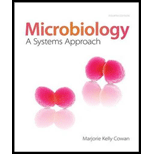
Microbiology: A Systems Approach
4th Edition
ISBN: 9780073402437
Author: Marjorie Kelly Cowan Professor
Publisher: McGraw-Hill Education
expand_more
expand_more
format_list_bulleted
Concept explainers
Question
Chapter 18, Problem 1CM
Summary Introduction
To draw:
A concept map that describes the relationships among the given key terms.
Concept introduction:
Staphylococcus aureus and Streptococcus pyogenes are responsible for causing the majority of the skin infections. Skin exposes an environment that is unfriendly for the growth of many microorganisms. Many microbes were found living under the skin and the majority of them resided within the outermost layer of the epidermis of the skin. These microbes are responsible for causing several infectious skin conditions.
Expert Solution & Answer
Want to see the full answer?
Check out a sample textbook solution
Students have asked these similar questions
Please draw in the missing answer, thank you
Please fill in all blank questions, Thank you
please fill in missing parts , thank you
Chapter 18 Solutions
Microbiology: A Systems Approach
Ch. 18.1 - Describe the important anatomical features of the...Ch. 18.1 - Prob. 2AYPCh. 18.2 - Prob. 3AYPCh. 18.3 - Prob. 2CFCh. 18.3 - Prob. 4AYPCh. 18.3 - Prob. 5AYPCh. 18.3 - Prob. 6AYPCh. 18.3 - Prob. 7AYPCh. 18.3 - Prob. 8AYPCh. 18.3 - Prob. 9AYP
Ch. 18.4 - Prob. 10AYPCh. 18.4 - Prob. 11AYPCh. 18.5 - List the types of normal biota presently known to...Ch. 18.6 - Prob. 13AYPCh. 18.6 - Prob. 14AYPCh. 18 - Prob. 1CFCh. 18 - Prob. 1MCQCh. 18 - Prob. 2MCQCh. 18 - Which of the following is probably the most...Ch. 18 - Prob. 4MCQCh. 18 - Prob. 5MCQCh. 18 - Prob. 6MCQCh. 18 - Prob. 7MCQCh. 18 - Prob. 8MCQCh. 18 - Prob. 9MCQCh. 18 - Prob. 10MCQCh. 18 - Prob. 11TFCh. 18 - Prob. 12TFCh. 18 - Prob. 13TFCh. 18 - Prob. 14TFCh. 18 - Prob. 15TFCh. 18 - Prob. 1CTQCh. 18 - Prob. 2CTQCh. 18 - Prob. 3CTQCh. 18 - Prob. 4CTQCh. 18 - a. Conduct additional research, and discuss...Ch. 18 - Prob. 6CTQCh. 18 - Prob. 7CTQCh. 18 - Prob. 8CTQCh. 18 - Prob. 9CTQCh. 18 - Prob. 10CTQCh. 18 - Prob. 1CCCh. 18 - Prob. 2CCCh. 18 - Prob. 3CCCh. 18 - Prob. 4CCCh. 18 - Prob. 1VCCh. 18 - Prob. 1CM
Knowledge Booster
Learn more about
Need a deep-dive on the concept behind this application? Look no further. Learn more about this topic, biology and related others by exploring similar questions and additional content below.Similar questions
- please draw in the answers, thank youarrow_forwarda. On this first grid, assume that the DNA and RNA templates are read left to right. DNA DNA mRNA codon tRNA anticodon polypeptide _strand strand C с A T G A U G C A TRP b. Now do this AGAIN assuming that the DNA and RNA templates are read right to left. DNA DNA strand strand C mRNA codon tRNA anticodon polypeptide 0 A T G A U G с A TRParrow_forwardplease answer all question below with the following answer choice, thank you!arrow_forward
- please draw in the answeres, thank youarrow_forwardA) What is being shown here?B) What is indicated by the RED arrow?C) What is indicated by the BLUE arrow?arrow_forwardPlease identify the curve shown below. What does this curve represent? Please identify A, B, C, D, and E (the orange oval). What is occurring in these regions?arrow_forward
- Please identify the test shown here. 1) What is the test? 2) What does the test indicate? How is it performed? What is CX? 3) Why might the test be performed in a clinical setting? GEN CZ CX CPZ PTZ CACarrow_forwardDetermine how much ATP would a cell produce when using fermentation of a 50 mM glucose solution?arrow_forwardDetermine how much ATP would a cell produce when using aerobic respiration of a 7 mM glucose solution?arrow_forward
- Determine how much ATP would a cell produce when using aerobic respiration to degrade one small protein molecule into 12 molecules of malic acid, how many ATP would that cell make? Malic acid is an intermediate in the Krebs cycle. Assume there is no other carbon source and no acetyl-CoA.arrow_forwardIdentify each of the major endocrine glandsarrow_forwardCome up with a few questions and answers for umbrella species, keystone species, redunant species, and aquatic keystone speciesarrow_forward
arrow_back_ios
SEE MORE QUESTIONS
arrow_forward_ios
Recommended textbooks for you
 Medical Terminology for Health Professions, Spira...Health & NutritionISBN:9781305634350Author:Ann Ehrlich, Carol L. Schroeder, Laura Ehrlich, Katrina A. SchroederPublisher:Cengage Learning
Medical Terminology for Health Professions, Spira...Health & NutritionISBN:9781305634350Author:Ann Ehrlich, Carol L. Schroeder, Laura Ehrlich, Katrina A. SchroederPublisher:Cengage Learning Comprehensive Medical Assisting: Administrative a...NursingISBN:9781305964792Author:Wilburta Q. Lindh, Carol D. Tamparo, Barbara M. Dahl, Julie Morris, Cindy CorreaPublisher:Cengage LearningEssentials of Pharmacology for Health ProfessionsNursingISBN:9781305441620Author:WOODROWPublisher:Cengage
Comprehensive Medical Assisting: Administrative a...NursingISBN:9781305964792Author:Wilburta Q. Lindh, Carol D. Tamparo, Barbara M. Dahl, Julie Morris, Cindy CorreaPublisher:Cengage LearningEssentials of Pharmacology for Health ProfessionsNursingISBN:9781305441620Author:WOODROWPublisher:Cengage



Medical Terminology for Health Professions, Spira...
Health & Nutrition
ISBN:9781305634350
Author:Ann Ehrlich, Carol L. Schroeder, Laura Ehrlich, Katrina A. Schroeder
Publisher:Cengage Learning

Comprehensive Medical Assisting: Administrative a...
Nursing
ISBN:9781305964792
Author:Wilburta Q. Lindh, Carol D. Tamparo, Barbara M. Dahl, Julie Morris, Cindy Correa
Publisher:Cengage Learning

Essentials of Pharmacology for Health Professions
Nursing
ISBN:9781305441620
Author:WOODROW
Publisher:Cengage
